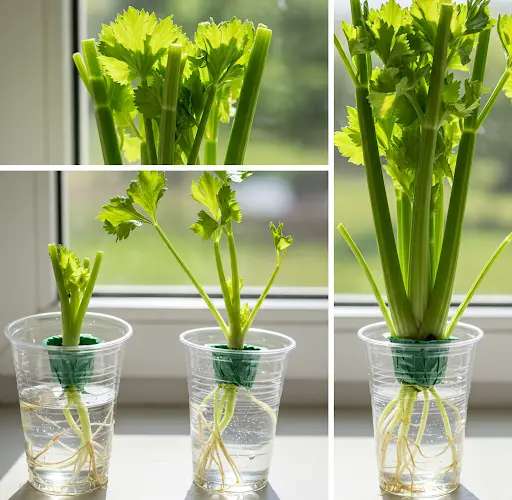How to Grow Celery at Home – No Garden Needed
Celery is often thought of as a tricky vegetable to grow, mainly because it has a long growing season and prefers cooler temperatures. But with a little patience and the right setup, growing celery at home is not only possible — it’s actually quite easy, even without a garden. Whether you’re working with a small balcony, kitchen windowsill, or a few containers on your porch, you can enjoy fresh, homegrown celery that’s crisp, healthy, and chemical-free.
Why Grow Celery at Home?
Growing celery at home has several benefits. First, it allows you to have complete control over what goes into your food — no pesticides, no synthetic fertilizers. Homegrown celery is typically more flavorful and aromatic than store-bought versions, which are often grown for appearance and shelf life rather than taste.
Another bonus: celery is a cut-and-come-again plant. This means you can harvest individual stalks as needed while the plant continues to grow, providing a steady supply for soups, stir-fries, juices, or healthy snacks.
Ways to Grow Celery Without a Garden
You don’t need an outdoor plot or large garden beds. Celery grows well in containers, grow bags, or even from kitchen scraps. Here are a few options:
-
Containers or Pots: Choose a pot at least 8 inches deep with good drainage. Celery has shallow roots but needs moist, loose soil.
-
Grow Bags: Fabric grow bags allow excellent drainage and airflow. A medium-sized bag is ideal for one or two celery plants.
-
Regrowing from Kitchen Scraps: This is the easiest way to start if you’ve already got a store-bought celery bunch. You can regrow the base in water, then transfer it to soil.
How to Regrow Celery from Scraps
This is a fun and beginner-friendly way to grow celery at home:
-
Cut the base: After using the stalks from a celery bunch, save the bottom 2–3 inches of the root base.
-
Place in water: Put the base in a shallow bowl with about 1 inch of water. Place it on a sunny windowsill.
-
Wait for growth: Within 3–5 days, you’ll see new leaves and tiny roots forming in the center.
-
Transfer to soil: After a week or so, plant it in potting soil, covering the base while keeping the new growth above the soil line.
This simple process gives your plant a great head start and is perfect for small spaces.
Growing Celery from Seeds
If you prefer to grow from scratch, celery seeds are widely available and affordable. Here’s how:
-
Soak the seeds: Celery seeds are slow to germinate. Soak them in warm water overnight to speed things up.
-
Start indoors: Sow the seeds in small pots or seed trays, lightly covering them with soil. Keep them warm and moist.
-
Transplant when ready: Once the seedlings are about 3 inches tall and have a few true leaves, transplant them into their final container or grow bag.
Light and Water Requirements
Celery loves moisture and partial to full sun. Ideally, give it 6 hours of sun per day. Indoors, a south-facing window or supplemental grow light works well.
Keep the soil consistently moist, but not soggy. Dry conditions cause the stalks to become thin and bitter. Water deeply whenever the top inch of soil feels dry.
Mulching around the base of the plant helps retain moisture and regulate temperature.
Feeding and Maintenance
Celery is a heavy feeder. Use a balanced organic fertilizer every two weeks or mix compost into the soil before planting. Liquid seaweed or compost tea also works well to encourage healthy, leafy growth.
Remove any yellowing or damaged leaves to keep the plant focused on producing healthy stalks. As the plant grows, you can also gently tie the outer stalks together to help them grow tall and straight.
Harvesting
Celery is usually ready to harvest about 3–4 months after planting. However, you don’t have to wait until the entire head matures. You can begin snipping individual stalks from the outside as soon as they reach about 8 inches tall.
To harvest the entire plant, cut it at the base using a sharp knife. If you leave a couple of inches above the soil, you may even get a second, smaller round of growth.
Common Issues
Celery is relatively pest-resistant when grown at home, but you may encounter aphids, slugs, or fungal issues in humid conditions. Keep the plant well-spaced for air circulation, and inspect it regularly. Natural sprays like neem oil or garlic water can help deter pests.
Final Thoughts
Celery might have a reputation for being a bit high-maintenance, but in the right setup, it’s a surprisingly easy and rewarding plant to grow at home. Whether you’re starting from seed or regrowing from scraps, all it takes is a bit of time, regular watering, and sunlight. The result is a crisp, fresh harvest that’s perfect for adding a healthy crunch to your meals — all without needing a backyard or traditional garden.



